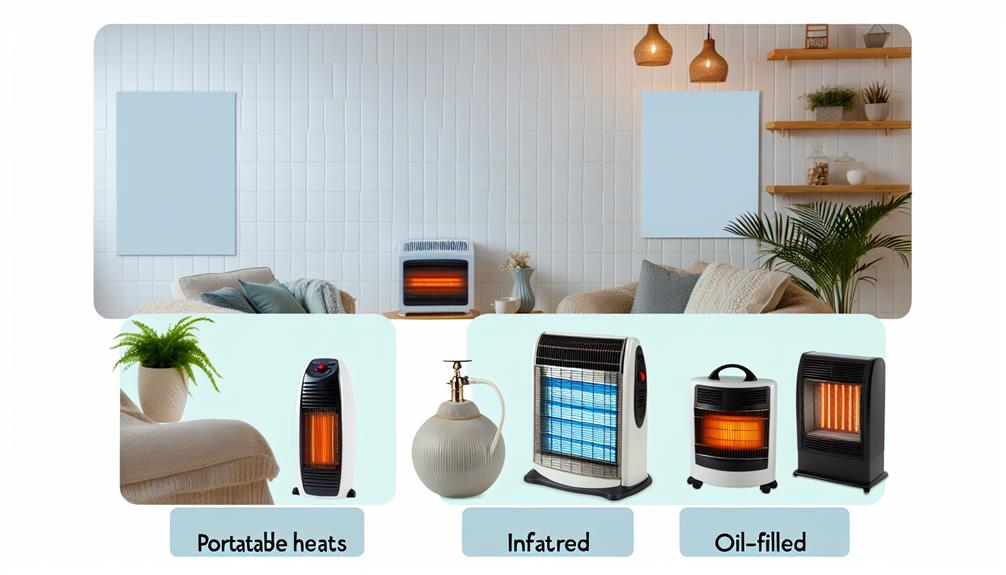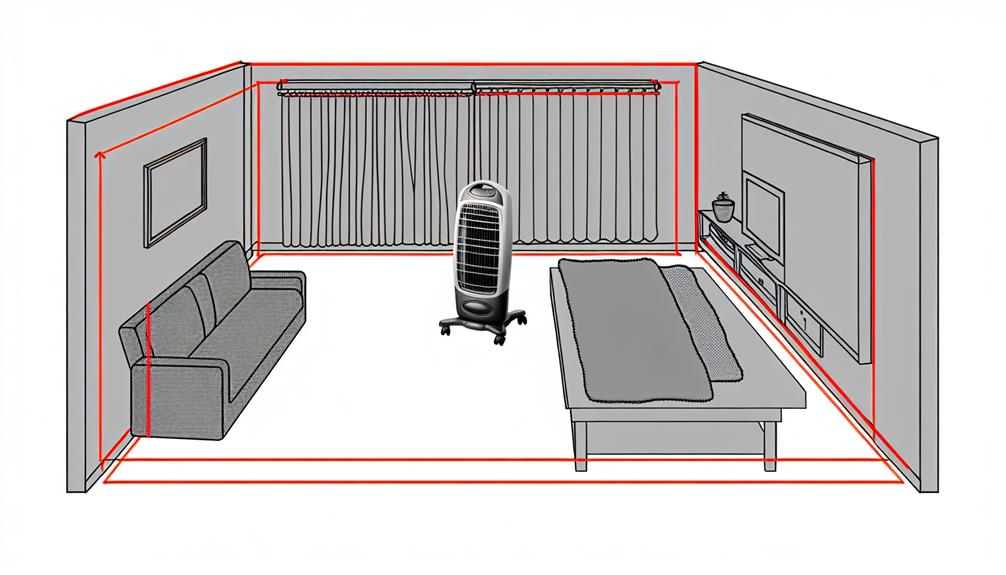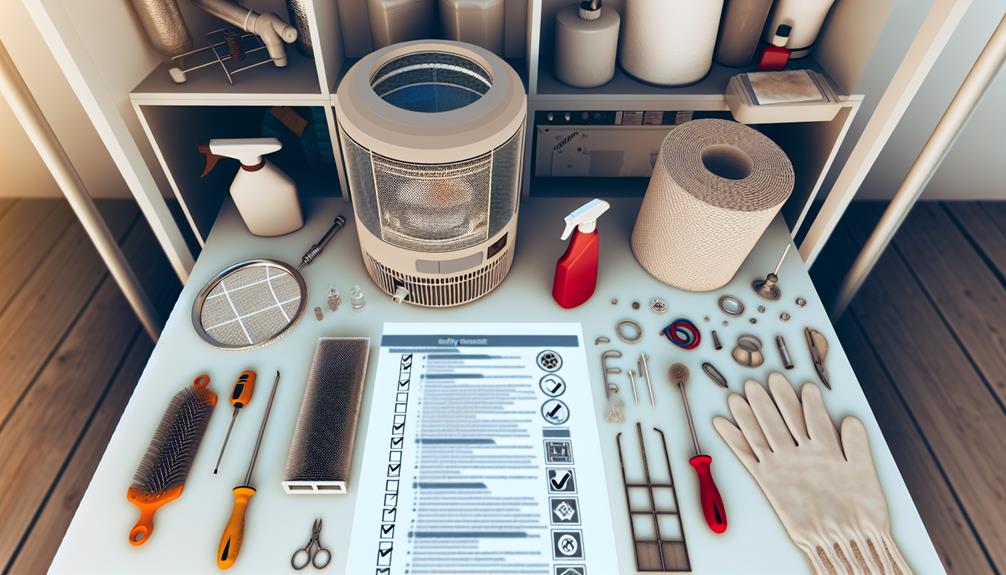As winter's whisper winds its way into your world, you're likely looking to your portable heater for warmth and comfort. Yet, it's essential to recognize that these convenient contraptions come with critical considerations to ensure your safety and their efficiency. You've got to navigate the nuances—from understanding the different types of heaters to selecting the size that suits your space. Proper placement isn't just about maximizing warmth; it's a fundamental factor in preventing potential hazards. And while you may be adept at adjusting the settings to your liking, are you aware of the maintenance must-dos that keep your heater humming healthily? As you seek to stay snug without a spike in your energy bills, you'll want to uncover the energy-saving strategies that savvy users swear by. Let's embark on a journey through the pivotal practices that promise to keep you and your heater operating in harmony, as there's much to consider beyond simply plugging in and powering on.
Key Takeaways
- Understand the different types of portable heaters and choose the one that suits your needs, such as convection heaters, radiant heaters, ceramic heaters, or oil-filled radiators.
- Prioritize heating technology and safety features when selecting a portable heater.
- Consider the square footage of the room and choose a heater with appropriate wattage (usually 10 watts per square foot) for efficient heating.
- Ensure proper placement and installation by keeping the heater away from flammable items, providing adequate ventilation, and placing it on a stable surface.
Understanding Portable Heater Types

When choosing a portable heater, it's essential to understand the various types available, each with its unique features and ideal use cases. The heating technology behind each model impacts not only your comfort but also your safety and operating costs.
Convection heaters are a common choice—they work by warming the air in a room, which then circulates to create a consistent temperature. Look for models with built-in thermostats and overheat protection, as these safety features are crucial to prevent accidents and maintain efficiency.
Radiant heaters, on the other hand, deliver heat directly to objects and people in their path. They're perfect for spot heating and use infrared technology to provide warmth without needing to heat the entire space. Safety features to watch for include tip-over switches and cool-touch exteriors, which help minimize fire risk and burns.
Ceramic heaters are a type of convection heater but with a twist: they use ceramic plates to absorb and radiate heat. This makes them faster at heating up and more energy-efficient. Safety features such as automatic shutoff sensors are typically standard in these units, offering an extra layer of protection.
Oil-filled radiators, resembling old-school radiators, use heated oil to warm up a room. They're silent and effective for prolonged use, making them ideal for bedrooms. However, they can get quite hot to the touch, so models with a stay-cool body and overheat protection are safer choices.
Regardless of the type, it's important to prioritize heating technology that suits your space and to always opt for models with robust safety features. These considerations will help ensure that you stay warm and secure throughout the colder months.
Selecting the Right Heater Size
Choosing the correct heater size is crucial for optimal comfort and efficiency in your space. You'll need to consider the compatibility of the heater with the size of the room you're aiming to warm. Paying attention to the heater's wattage will help ensure it has the power necessary for the area without wasting energy.
Room Size Compatibility
How do you ensure your portable heater is the perfect fit for your space? It's crucial to match the heater's output with the room's size for optimal heater efficiency and to meet ventilation requirements. Here's how:
- Assess the Area
- Measure the room's square footage.
- Select a heater with the appropriate wattage (usually 10 watts per square foot).
- Consider the Space
- High ceilings may require more power.
- Open areas might need heaters with fans for better distribution.
Heater Wattage Considerations
Understanding that different spaces require varying levels of heat output, it's essential to select a portable heater with a wattage that aligns with the specific needs of your room. The right wattage ensures efficient heating and can impact both the heater lifespan and the initial cost. Here's a simple guide:
| Room Size (sq ft) | Suggested Wattage (Watts) | Estimated Heating Capacity (sq ft) |
|---|---|---|
| Up to 150 | 750-1500 | 50-150 |
| 150-250 | 1500-2500 | 150-250 |
| 250-350 | 2500-3500 | 250-350 |
Select a heater that provides just enough heat for your space to avoid unnecessary power consumption, which can lower the heater lifespan and increase costs over time. Remember, a higher wattage doesn't always equate to better; it's about finding the sweet spot for your particular needs.
Proper Placement and Installation

Ensuring your portable heater is correctly placed and installed is crucial for both efficiency and safety. You've got to pay special attention to two main factors: heater clearance and ventilation requirements. These aren't just suggestions; they're imperative to prevent fire hazards and maintain a healthy, breathable atmosphere in your space.
Here's what you need to keep in mind:
- Heater Clearance
- Keep the heater at least three feet away from anything that can burn, such as papers, clothing, and rugs.
- Don't place it under a desk or in a cluttered space. The heater needs room to "breathe."
- Ventilation Requirements
- Ensure the room has adequate ventilation, especially if you're using a combustion heater.
- Cracking a window slightly or ensuring an air vent is open can help prevent carbon monoxide buildup.
Moreover, when you're installing your portable heater, consider these points:
- Stable Surface
- Place the heater on a flat, level surface to avoid it tipping over.
- Avoid placing it on furniture; it should always be on the ground.
- Power Source
- Plug the heater directly into an outlet. Don't use an extension cord, as it can overheat.
- Make sure the plug fits snugly into the outlet to prevent electrical malfunctions.
Operating Heaters Safely
Once you've positioned your portable heater correctly, it's vital to operate it with safety in mind to reduce the risk of accidents. Fire hazards are a primary concern with portable heaters, so you'll want to be attentive and responsible every time you use your unit. Always follow the manufacturer's instructions for operation to the letter, and never leave a heater unattended while it's on. If you need to leave the room or go to sleep, it's crucial that you turn the heater off first.
Keep combustible materials such as curtains, furniture, and clothing at least three feet away from the heater to prevent them from catching fire. Additionally, ensure that the heater's plug fits snugly into the outlet, as a loose plug can overheat and lead to a fire. Don't plug other electrical devices into the same outlet as the heater, and never use an extension cord, as this increases the chance of overheating and fire.
Carbon monoxide is another serious risk when using fuel-burning portable heaters. To avoid the dangers of carbon monoxide poisoning, it's critical to ensure proper ventilation. If your heater uses fuel, it should never be used in a confined space without adequate airflow. It's also wise to install a carbon monoxide detector in your home to alert you to the presence of this odorless, colorless gas.
Maintenance and Upkeep Tips

To ensure your portable heater operates efficiently, you'll need to establish a regular cleaning routine. It's also crucial to adhere to a scheduled inspection and repair plan to address any potential issues before they escalate. Neglecting these steps can compromise your heater's performance and safety.
Regular Cleaning Routine
Maintaining a clean portable heater not only extends its lifespan but also optimizes its performance, so it's crucial to establish a regular cleaning routine. Here's how you can keep your heater in top shape:
- Perform Filter Replacement:
- Check the manufacturer's guide for the recommended schedule.
- Replace or clean filters to prevent dust accumulation and maintain air quality.
- Mitigate Dust Accumulation:
- Use a vacuum with a soft brush attachment to gently remove dust from the heater's exterior and vents.
- Wipe down the surface with a dry microfiber cloth to snag any lingering particles.
Staying on top of these tasks will ensure your portable heater runs safely and efficiently, keeping you cozy without any hiccups.
Inspection and Repair Schedule
In addition to regular cleaning, it's essential to adhere to a thorough inspection and repair schedule to keep your portable heater operating at its best. Regular checks can uncover potential hazards or malfunctions before they escalate. You should consult your heater's manual for specific maintenance recommendations and establish a routine to inspect your device at least once before the heating season begins.
Stay informed about heater recalls to ensure your model isn't affected by safety issues. In case of defects or performance concerns, check your heater's warranty coverage for repair or replacement options. Don't attempt to repair a faulty heater yourself unless you're qualified; always seek professional assistance. A well-maintained heater is not only safer but also more energy-efficient, providing reliable warmth when you need it.
Energy-Saving Practices
Maximizing your portable heater's efficiency hinges on adopting energy-saving practices that can significantly reduce your electricity bills. It's not just about turning it on and off; it's about smart usage and understanding how to get the most heat for the least amount of energy. Let's delve into the specifics:
- Thermostat Settings and Insulation
- *Thermostat Settings*: Dialing in the correct thermostat setting is crucial. You don't need to keep the heater on full blast all the time. Aim for a comfortable temperature that doesn't overwork the device.
- Lower the thermostat when you're not in the room.
- Consider a programmable thermostat to manage heating schedules.
- *Insulation Benefits*: Ensuring the space is well insulated keeps the heat in, which means your heater works less.
- Seal drafts around windows and doors.
- Use insulated curtains to prevent heat loss.
- Energy-Saving Habits
- *Mindful Operation*: Don't leave the heater running when it's not needed. Turn it off when you leave the room for an extended period.
- Utilize the heater's timer functions.
- Layer up with warm clothing to reduce reliance on the heater.
- *Regular Maintenance*: Keeping the heater clean and in good repair ensures it operates at peak efficiency.
- Clean filters and fans regularly.
- Have the heater serviced if you notice any decline in performance.
Implementing these practices doesn't just help your wallet; it also contributes to a greener, more sustainable lifestyle. Remember, every degree and every watt saved adds up over time, leading to substantial energy conservation.
Frequently Asked Questions
Can I Use a Portable Heater if the Electrical Wiring in My Home Is Old or Hasn't Been Inspected Recently?
You're concerned about your old wiring and heater use, right? Well, it's crucial you don't overlook safety. Before plugging in a portable heater, get an electrical assessment. Outdated or uninspected wiring can be a hazard. To be safe, consider a wiring upgrade if necessary. This proactive approach ensures not only your safety but also the efficient operation of your heating equipment. Don't take risks with electricity—it's always better to be sure.
How Does Altitude Affect the Efficiency and Safety of Portable Heaters?
At high altitudes, you're dealing with thinner air—less oxygen can make combustion-based portable heaters less efficient and potentially hazardous. It's crucial to ensure your heater is rated for high altitude use. Look for models with oxygen depletion sensors, as they'll shut off if the oxygen levels drop too low, providing a vital safety net. Remember, altitude impacts both performance and safety, so stay informed and take the necessary precautions.
Are There Any Health Concerns Associated With Using Portable Heaters for Prolonged Periods?
Yes, using portable heaters for extended periods can impact your health. You've got to watch out for indoor air quality, as some heaters can reduce oxygen levels, increasing carbon monoxide risks. Always ensure proper ventilation and choose units with safety features. Don't leave them running unattended, and maintain a clear space around them to prevent accidents. Protect yourself by staying informed and cautious with these devices.
Can I Use an Extension Cord With My Portable Heater, and if So, What Type Should I Use?
You shouldn't beat around the bush with extension risks. It's critical not to use just any old extension cord with your portable heater. Look for one that meets the necessary cord specifications, like the right gauge and power rating for your particular heater model. This isn't just about efficiency; it's a safety imperative. Using the wrong type can lead to overheating and potentially cause a fire. Always play it safe.
How Do I Safely Dispose of or Recycle an Old or Non-Functioning Portable Heater?
When your heater's lifespan ends, don't just toss it out. First, check if it's repairable—some shops might take it off your hands. If it's beyond repair, consider donation options for parts or recycling. Many communities have e-waste programs where you can drop off old electronics. Ensure you're disposing of your heater responsibly to avoid environmental harm, and always follow your local disposal guidelines for electronic items.
